Bagarius yarrelli
Goonch
SynonymsTop ↑
Bagrus yarrelli Sykes, 1839; Pimelodus carnaticus Jerdon, 1849; Bagarius lica Volz, 1903; Bagarius nieuwenhuisii Popta, 1904
Etymology
Bagarius: from ‘Vaghari’, a local name in Calcutta (Kolkata).
yarrelli: named for fellow zoologist and friend of the author William Yarrell (1784-1856).
Classification
Order: Siluriformes Family: Sisoridae
Distribution
Currently considered to have a wide but disjointed distribution extending southeastward from the Indus River, Pakistan, and including the Ganges and most major rivers of the Indian peninsula, Nepal, and Bangladesh, plus the Irrawaddy and Salween in Myanmar, the Mekong system in Laos and Cambodia, Chao Phraya in Thailand, several rivers of the Malay Peninsula, and the Greater Sunda Islands (the syonyms Bagarius lica and B. nieuwenhuisii were described from Sumatra and Borneo, respectively).
This distribution appears doubtful, however, and it seems likely that future studies will reveal that Indian and Southeast Asian populations are not conspecific with several species possibly involved (see ‘Notes’).
Type locality is ‘Mota Mola at Poona, Deccan, India’, referring to the Mutha Mula River at Pune, Maharashtra state, western India.
Habitat
Inhabits large river channels and typically associated with fast-flowing, turbulent rapids where it takes shelter among boulders and large rocks. Juveniles may be found in smaller tributaries.
Adults perform seasonal spawning migrations when rivers swell and become turbid, and in the Mekong have been observed to move in large groups.
Maximum Standard Length
1300 – 2000 mm.
Aquarium SizeTop ↑
Suitable only for public installations or the very largest, highly-specialised private aquaria.
Maintenance
Prefers dim lighting and access to refuges in the form of driftwood, large rocks or lengths of plastic piping.
A large, mature filter system, rigorous maintenance regime comprising weekly water changes of 50-70% tank volume, and provision of highly-oxygenated water with plenty of movement should be considered mandatory.
Water Conditions
Temperature: 16 – 23 °C
pH: 6.0 – 7.5
Hardness: 36 – 215 ppm
Diet
An obligate predator feeding on smaller fishes, amphibians, crustaceans and other invertebrates in nature but in most cases adapting well to dead alternatives in captivity.
Young fish can be offered chironomid larvae (bloodworm), small earthworms, chopped prawn and suchlike while adults will accept strips of fish flesh, whole prawns/shrimp, mussels, live river shrimp, larger earthworms, etc.
This species should not be fed mammalian or avian meat such as beef heart or chicken since some of the lipids contained in these cannot be properly metabolised by the fish and may cause excess fat deposits and even organ degeneration.
Similarly there is no benefit in the use of ‘feeder’ fish such as livebearers or small goldfish which carry with them the risk of parasite or disease introduction and at any rate tend not have a high nutritional value unless properly conditioned beforehand.
Behaviour and CompatibilityTop ↑
Best maintained alone.
NotesTop ↑
This species is also known as the ‘giant devil catfish’, ‘giant painted catfish’, and ‘sand shark’, and is fished for food across much of its range.
It is clearly unsuitable for the home aquarium given its eventual size and natural behaviour, and we know of only a handful of private aquarists with the facilities required to house it long-term.
Following Roberts (1983) B. yarrelli and B. bagarius can be distinguished from other congeners by the following characters: cranium and predorsal plate covered with horny skin differentiated into elongate unculiferous plaques; supraoccipital crest and predorsal plate without sharp ridges; skin on sides of head and on body with elongate unculiferous plaques similar in shape but generally smaller than those on dorsal surface of head; body depth 4.7-8.5 (mean 6.0); no large darkly pigmented spot or blotch on side of body between darkly pigmented areas near dorsal and adipose fins.
B. yarrelli can be told apart from B. bagarius as follows: pelvic-fin origin usually posterior (vs. anterior in B. bagarius) to a vertical line through base of last dorsal-fin ray; adipose-fin origin anterior to, on, or slightly posterior (vs. slightly to markedly posterior) to a vertical line through anal-fin origin; total external gill rakers on first gill arch 8-11 (vs. 6-9); pectoral-fin rays 11-14 (vs. 9-12); elongate neural spines 2-5, slender (vs. 4-8, distally expanded); abdominal vertebrae 21-24 (vs. 17-20).
The genus Bagarius is distinguished from all other genera in the putative subfamily Sisoridae by having markedly heterodont teeth in the lower jaw. Teeth are present in two or three outer rows of relatively numerous, close-set conical teeth, and one or two inner rows of less numerous, widely separated, and much larger conical teeth (vs. dentition of the lower jaw consisting of only small conical teeth, or a roughened bony plate).
The grouping currently contains four species but is in urgent need of review with a number of additional taxa thought to exist and B. yarrelli possibly representing a synonym of B. bagarius.
References
- Sykes, W. H., 1839 - Proceedings of the Zoological Society of London 1838 (pt 6): 157-165
On the fishes of the Deccan. - Ferraris, C. J., Jr., 2007 - Zootaxa 1418: 1-628
Checklist of catfishes, recent and fossil (Osteichthyes: Siluriformes), and catalogue of siluriform primary types. - Kottelat, M., 2001 - WHT Publications, Colombo: 1-198
Fishes of Laos. - Kottelat, M., 2001 - Environment and Social Development Unit, East Asia and Pacific Region. The World Bank: i-iii + 1-123 + 1-18
Freshwater fishes of northern Vietnam. A preliminary check-list of the fishes known or expected to occur in northern Vietnam with comments on systematics and nomenclature. - Kottelat, M. and E. Widjanarti, 2005 - The Raffles Bulletin of ZoologySupplement 13: 139-173
The fishes of Danau Sentarum National Park and the Kapuas Lakes area, Kalimantan Barat, Indonesia. - Ng, H. H. and I. Rachmatika, 1999 - The Raffles Bulletin of Zoology 47(1): 167-183
The catfishes (Teleostei: Siluriformes) of Bentuang Karimun National Park, West Kalimantan, Indonesia. - Ng, H. H. and M. Kottelat, 2000 - Journal of South Asian Natural History 5(1): 7-15
Description of three new species of catfishes (Teleostei: Akysidae and Sisoridae) from Laos and Vietnam. - Rainboth, W. J., 1996 - Rome, FAO: 1-265
FAO species identification field guide for fishery purposes. Fishes of the Cambodian Mekong. - Roberts, T. R., 1989 - Memoirs of the California Academy of Sciences No. 14: i-xii + 1-210
The freshwater fishes of western Borneo (Kalimantan Barat, Indonesia). - Roberts, T. R., 1983 - Copeia 1983(2): 435-445
Revision of the South and Southeast Asian Sisorid Catfish Genus Bagarius, with Description of a New Species from the Mekong. - Tan, H. H. and H. H. Ng, 1999 - Journal of Natural History 34(2): 267-303
The catfishes (Teleostei: Siluriformes) of central Sumatra. - Thomson, A. W. and L. M. Page, 2006 - Zootaxa 1345: 1-96
Genera of the Asian catfish families Sisoridae and Erethistidae (Teleostei: Siluriformes). - Yeamin Hossain, M., 2009 - Sains Malaysiana 39(2): 157-159
New Maximum Size Record for the Goonch Bagarius yarrelli (Sykes 1839) (Siluriformes: Sisoridae) from the Ganges River.
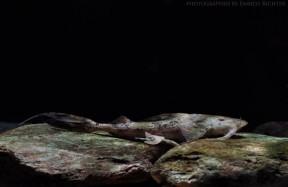

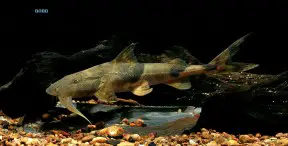
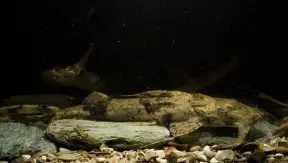
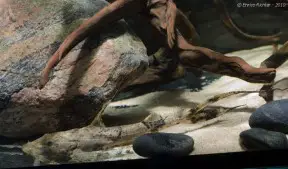
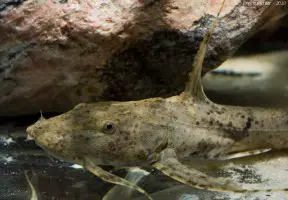


February 10th, 2014 at 10:54 pm
I bought one in 1997 and it appears to have died in January 2009. No body was found but this is not uncommon in this tank.
I did not provide the water current that I later learned it required. It was not the aggressive fish that it is portrayed as and among catfish in the tank was near the bottom of the line of power. It was 15cm when I got it and was estimated at 93 cm or so when friends last swam with it in the tank. My 150cm 23 year old female Wallago leerii is the queen of this tank and she was very viscous towards the Bagrus yarrelli always chasing it away from the front area. The Yarrelli choose to hide among large pieces of bogwood at depths of 240 to 270cm in the tank which is L shaped and 1097cm long and 823cm wide containing approx. 196,000 litres of water. Several filter systems have been used but currently it has 2 large bead filters with six blue bag pre filters and a natural gas fired tankless hot water heater. It is connected to a smaller 56,000 litre tank with the water changing between them and an overflow out of the larger tank to a large outdoor pond. Fresh water is added at the rate of about 7,000 litres a day to the larger tank. The smaller tank also has a large bead filter and fresh water is added to that section daily up to 3,000 litres from an oil fired hot water heater. Both tanks have multiple large linear air pumps with several air diffusers to circulate the water vertically. My mistake was not having a horizontal circulating pump like the one Oliver Lucanus sells to public aquariums in North America. He did bring one in 2010 and displayed it to several large fish enthusiasts by installing it in both of the larger tanks. This is what the yarrelli really needed. As the moderators of this forum suggest I also believe that this fish deserves a very large aquarium or pond.